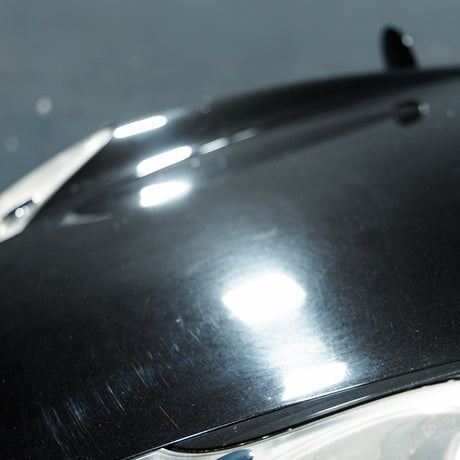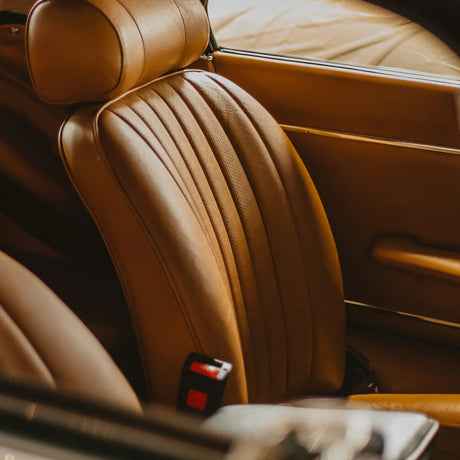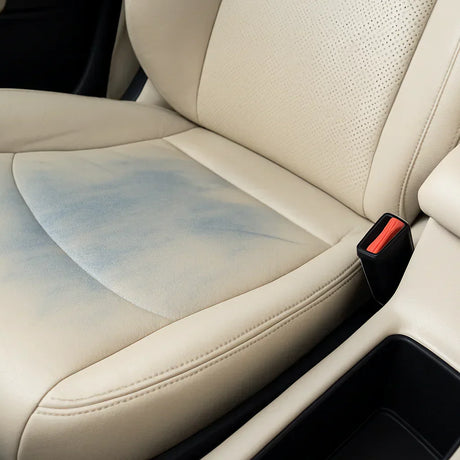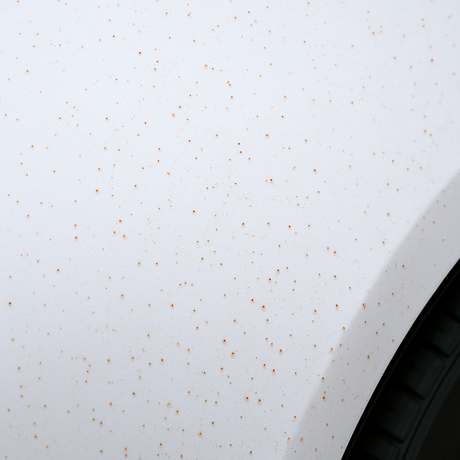In Swabia, you learn quickly: there are actually only two car brands
Swissvax: “Hanna, thank you for letting us learn more about you and your passion for design and cars. What kind of car are you currently driving and why that one?”
Hanna: Currently, I drive a 1984 Mercedes W123 230 CE Coupe in Champagne Metallic. The reason I bought this model is due to the unmistakable design of this sports coupe without a B-pillar, combined with the reliability and longevity that the W123 series is known for.
Swissvax: "Is this your first classic car?"
Hanna: No, it's my second. Before, I also had a W123, but as a sedan in anthracite from 1978.

Swissvax: "Why Mercedes?"
Hanna: I spent my studies as an industrial designer in the Stuttgart area. As a Westphalian among the Swabians, you quickly learn that in this region, there are really only two car brands your heart should beat for. Apart from the great vehicle design, which fascinated me early on with the old Mercedes, I knew that the parts supply for classic models of this brand is secured. So, the choice was easy for me. The fact that it wasn’t a model from the other famous Stuttgart car manufacturer was also due to my budget at the time. Mercedes, in contrast to Porsche, offers a financially easier entry into the world of classic cars, which makes it particularly interesting for younger people.

Swissvax: "We have seen that you also get photographed and drive classic Porsche models. What connection do you have to Porsche?"
Hanna: During my school years, I drew a lot, especially cars. That’s when I first began looking at different brands and, particularly, their brand identities, including Porsche. From that point on, I knew I wanted to stay in the design field and decided to study industrial design in Pforzheim. In this program, I learned to work with various products in a design and drawing context, and it was through a study collaboration with Porsche that my attention turned back to the sports car manufacturer. Not long after, Porsche fascinated me so much that I did my internship there. Over time, my growing interest in the brand, along with my professional connections, developed into a network and a circle of friends. Now, I know many people who either work directly at Porsche, restore old Porsches, or are devoted to the brand through driving pleasure.
Swissvax: "Do you sometimes restore cars yourself? How did that come about?"
Hanna: The reason I started working on my cars came out of necessity. I desperately wanted a car when I got my driver’s license, but at the time, I didn’t have the means to afford repairs. During my school years, I did a career orientation internship at a Ford workshop and also worked there during the holidays. I really enjoyed the work. At 18, I then bought a Ford Focus through my contacts at the workshop, which I could do some of the work on myself because I had learned about the models. With my studies, my interest in classic cars grew, and I realized that old vehicles were much simpler to repair on my own. My first W123 sedan was unfortunately in such a poor technical condition that repairing it became a necessary evil just to get it to the finish line. I remember a faulty ignition lock, fuel hoses that the previous owner had patched with garden hoses, and of course, plenty of rust. For a while, I started the old thing with a screwdriver. But it worked! Currently, I am in the process of restoring a 1984 Land Rover Series 3 and preparing a 1987 W124 TD as my winter car.


Swissvax: “What relationship do you have with your cars?”
Hanna: My W123 coupe in Champagne is called Jürgen. I don't think I need to say more than that.
Swissvax: “You've been modeling since you were 13 and working on cars yourself – that's an interesting combination and stands out. How do women and men in the classic car scene react to this?"
Hanna: The classic car scene is still mainly a male-dominated world. For example, I restored my W123 coupe together with the W123 Club, and there are almost no women there. However, I was welcomed very warmly, and my enthusiasm and energy during the restoration process were well received – my being a woman made no difference here. It’s nice to see that, in recent times, more and more women are opening up to this subject. In general, it seems the classic car scene is evolving. Age and gender are becoming less of a concern, and what counts is the shared enthusiasm, as classic cars are emotionally charged, exciting, and their aesthetics have a unique appeal.

Swissvax: "Which car would you like to restore next?"
Hanna: As I mentioned earlier, I am fascinated by classic Mercedes for their design and functionality, as well as old Porsches. I would love to restore a 911 coupe, preferably a 3.0 SC or a 3.2 Carrera, because these models are already quite practical and sporty to drive, but they still maintain a fundamentally puristic design without too much electronics.
Swissvax: "Is it always classic cars that fascinate you, or can modern ones catch your interest too?"
Hanna: I know more about classic cars, but sure, modern vehicles are also exciting. Especially now at a turning point toward alternative drives, I’m also spending more time looking into these cars. My studies certainly sharpened my perspective, especially regarding design. However, many of the modern cars are too overloaded with electronics and gadgets, so I would always prefer an old car over a modern one for that reason.
Swissvax: “You work independently and for different clients in industrial design, graphic design, and also create your own art. What are you currently working on?”
Hanna: Right now, I’m working on several projects, mainly in the automotive sector. For a Porsche restoration company in Hamburg, I’m designing some new spare parts and also contributing to a new product line. The most exciting project for me at the moment is a collaboration with Porsche, which is about to be published. Here, I designed and implemented my own art car.
Swissvax: “Can you tell us more about your artwork?”
Hanna: What fascinates me most is how much can be expressed with just a few lines. Drawing is the central medium in my art, and I mostly choose the most expressive subject – the human being. In particular, I love drawing faces. To convey emotions through them, I often don't need a variety of colors or materials.
Swissvax: “What do you consider to be good or successful design? How do you define design?”
Hanna: I understand design as giving a feeling or even a function a body so it can be looked at or touched. In my view, good design is when it fulfills its specific purpose. At this point, it's not about taste yet.

Swissvax: "What has been your most beautiful moment or experience with your classic car so far?”
Hanna: I think there’s no single most beautiful moment for me. Everything has its time, and there are always beautiful experiences at each stage. The best for me is actually using my classic car in everyday life and being able to enjoy it every day.
Swissvax: "We see you at many events – which one has been your favorite so far and why?"
Hanna: So far, my interest in classic car events has mostly been focused on the younger scene, i.e., events organized and spread via social media. In the Porsche scene, especially, there are many smaller events that I’ve really enjoyed. Picking a true favorite is hard for me. Looking ahead, I would love to explore the more traditional classic car scene – perhaps join a large classic car rally, like the Silvretta Classic. That would be really fun for me.
Swissvax: "What do you personally associate with 'Care for your Dream'?"
Hanna: For me, it means not just working toward a dream, but actively preserving it and, of course, doing it as well as possible. A classic car is never truly finished. When you use these vehicles, there is always something to do. The idea that the car has already survived so many years motivates me to extend its life further. Maybe one day, I’ll be able to pass it on and transfer the dream to the next generation: All of this is only possible with the right care, a good understanding of the technology, and attention to detail.












